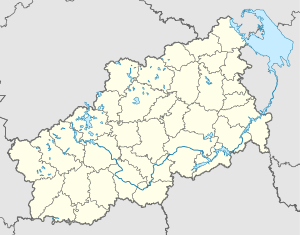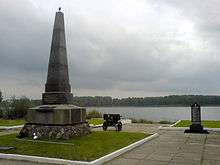Bologoye, Tver Oblast
| Bologoye (English) Бологое (Russian) | |
|---|---|
| - Town[1] - | |
 Kirova Street in Bologoye | |
.svg.png) Location of Tver Oblast in Russia | |
 Bologoye | |
|
| |
.png) |
|
|
| |
| Administrative status (as of December 2012) | |
| Country | Russia |
| Federal subject | Tver Oblast[1] |
| Administrative district | Bologovsky District[2] |
| Urban settlement | Bologoye[2] |
| Administrative center of | Bologovsky District,[3] Bologoye Urban Settlement[2] |
| Municipal status (as of July 2009) | |
| Municipal district | Bologovsky Municipal District[4] |
| Urban settlement | Bologoye Urban Settlement[4] |
| Administrative center of | Bologovsky Municipal District,[5] Bologoye Urban Settlement[4] |
| Statistics | |
| Population (2010 Census) | 23,494 inhabitants[6] |
| Time zone | MSK (UTC+03:00)[7] |
| First mentioned | 1495 |
| Postal code(s)[8] | 171070–171072, 171075, 171076, 171080, 171081 |
|
| |
| Bologoye on Wikimedia Commons | |
Bologoye (Russian: Болого́е) is a town and the administrative center of Bologovsky District in Tver Oblast, Russia, as well as a major railway hub. It is located approximately halfway between Moscow and St. Petersburg on the railway route connecting the two cities. Population: 23,494 (2010 Census);[6] 26,612 (2002 Census);[9] 35,926 (1989 Census).[10]
Etymology
The name of the town derives from the name of nearby Lake Bologoye.
History
The first mention of Bologoye in historic records dates back to 1495, which is considered its year of foundation.[11] In the course of the administrative reform carried out in 1708 by Peter the Great, Bologoye was included into Ingermanland Governorate (known since 1710 as St. Petersburg Governorate). In 1727, separate Novgorod Governorate was split off.[12] In 1770, it became a part of Valdaysky Uyezd of Novgorod Viceroyalty. In 1796, the viceroyalty was transformed into Novgorod Governorate.[13]
In 1851, Bologoye became a station of the Moscow – Saint Petersburg Railway. In the second half of the 19th century, the Rybinsk–Pskov–Vindava railway passed through Bologoye, turning it into a large railway junction. Railway-related industries have contributed significantly to the town's growth.
On June 3, 1917, Bologoye was granted town status.[14] Between April 1, 1919 and October 1920, the administrative center of the uyezd was transferred from Valday to Bologoye, but soon after it was moved back to Valday.[15]
In August 1927, the governorates and uyezds were abolished. Bologovsky District, with the administrative center in Bologoye, was established within Borovichi Okrug of Leningrad Oblast effective October 1, 1927.[16] It included parts of former Valdaysky and Borovichsky Uyezds.[16] On July 23, 1930, the okrugs were abolished and the districts were directly subordinated to the oblast.[17] On January 29, 1935, Bologovsky District was transferred to newly established Kalinin Oblast.[16][18]
On November 27, 2009, the town was the site of a derailment of an express train on the Moscow–St. Petersburg railway.
Administrative and municipal status
Within the framework of administrative divisions, Bologoye serves as the administrative center of Bologovsky District.[3] As an administrative division, it is, together with ten rural localities, incorporated within Bologovsky District as Bologoye Urban Settlement.[2] As a municipal division, this administrative unit also has urban settlement status and is a part of Bologovsky Municipal District.[4]
Economy
Industry
The industry of Bologoye mainly serves the railways.[19] Additionally, there are a pipe production factory, a glass-making factory, a metal production plant, as well as enterprises of construction and food industries.[20]
Transportation


Bologoye is a major railway hub, where four railway lines cross. One connects Moscow and St. Petersburg, while the other three connect the town with Rybinsk via Bezhetsk and Sonkovo, with Pskov via Valday and Staraya Russa, and with Velikiye Luki via Andreapol. There is passenger traffic along all these lines.
Bologoye has access to the M10 Highway, which connects Moscow and St. Petersburg. There are local roads as well.
Culture and recreation

Bologoye hosts Nikolay Dubravitsky Bologoye District Museum which specializes in the history of Bologovsky District.[21]
References
Notes
- 1 2 Law #34-ZO
- 1 2 3 4 Law #34-ZO stipulates that the borders of the settlements (administrative-territorial divisions) are identical to the borders of the urban and rural settlements (municipal divisions), and that the borders of the administrative districts are identical to the borders of the municipal districts. Law #20-ZO, which describes the borders and the composition of the municipal formations in Bologovsky Municipal District, lists the town of Bologoye as a part and the administrative center of Bologoye Urban Settlement of that district.
- 1 2 Государственный комитет Российской Федерации по статистике. Комитет Российской Федерации по стандартизации, метрологии и сертификации. №ОК 019-95 1 января 1997 г. «Общероссийский классификатор объектов административно-территориального деления. Код 28 208», в ред. изменения №259/2014 от 12 декабря 2014 г.. (State Statistics Committee of the Russian Federation. Committee of the Russian Federation on Standardization, Metrology, and Certification. #OK 019-95 January 1, 1997 Russian Classification of Objects of Administrative Division . Code 28 208, as amended by the Amendment #259/2014 of December 12, 2014. ).
- 1 2 3 4 Law #20-ZO
- ↑ Law #4-ZO
- 1 2 Russian Federal State Statistics Service (2011). "Всероссийская перепись населения 2010 года. Том 1" [2010 All-Russian Population Census, vol. 1]. Всероссийская перепись населения 2010 года (2010 All-Russia Population Census) (in Russian). Federal State Statistics Service. Retrieved June 29, 2012.
- ↑ Правительство Российской Федерации. Федеральный закон №107-ФЗ от 3 июня 2011 г. «Об исчислении времени», в ред. Федерального закона №271-ФЗ от 03 июля 2016 г. «О внесении изменений в Федеральный закон "Об исчислении времени"». Вступил в силу по истечении шестидесяти дней после дня официального опубликования (6 августа 2011 г.). Опубликован: "Российская газета", №120, 6 июня 2011 г. (Government of the Russian Federation. Federal Law #107-FZ of June 31, 2011 On Calculating Time, as amended by the Federal Law #271-FZ of July 03, 2016 On Amending Federal Law "On Calculating Time". Effective as of after sixty days following the day of the official publication.).
- ↑ Почта России. Информационно-вычислительный центр ОАСУ РПО. (Russian Post). Поиск объектов почтовой связи (Postal Objects Search) (Russian)
- ↑ Russian Federal State Statistics Service (May 21, 2004). "Численность населения России, субъектов Российской Федерации в составе федеральных округов, районов, городских поселений, сельских населённых пунктов – районных центров и сельских населённых пунктов с населением 3 тысячи и более человек" [Population of Russia, Its Federal Districts, Federal Subjects, Districts, Urban Localities, Rural Localities—Administrative Centers, and Rural Localities with Population of Over 3,000] (XLS). Всероссийская перепись населения 2002 года [All-Russia Population Census of 2002] (in Russian). Retrieved August 9, 2014.
- ↑ Demoscope Weekly (1989). "Всесоюзная перепись населения 1989 г. Численность наличного населения союзных и автономных республик, автономных областей и округов, краёв, областей, районов, городских поселений и сёл-райцентров" [All Union Population Census of 1989: Present Population of Union and Autonomous Republics, Autonomous Oblasts and Okrugs, Krais, Oblasts, Districts, Urban Settlements, and Villages Serving as District Administrative Centers]. Всесоюзная перепись населения 1989 года [All-Union Population Census of 1989] (in Russian). Институт демографии Национального исследовательского университета: Высшая школа экономики [Institute of Demography at the National Research University: Higher School of Economics]. Retrieved August 9, 2014.
- ↑ "Паспорт города". Bologoe-gorod.ru (in Russian). Administration of the town of Bologoye. 25 August 2014. Retrieved 19 July 2016.
- ↑ Snytko et al., p. 16
- ↑ Snytko et al., p. 22
- ↑ Snytko et al., p. 32
- ↑ Snytko et al., p. 35
- 1 2 3 Бологовский район (август 1927 г. - январь 1935 г.) (in Russian). Справочник истории административно-территориального деления Ленинградской области. Retrieved August 19, 2014.
- ↑ Snytko et al., p. 87
- ↑ Справка об изменениях в административно-территориальном делении Тверской губернии - Калининской области (in Russian). Архивы России. Retrieved August 19, 2014.
- ↑ Район в цифрах (in Russian). Администрация МО Бологовский район. Retrieved October 31, 2013.
- ↑ Информация о предприятиях и организациях МО "Бологовский район" (in Russian). Администрация МО Бологовский район. Retrieved November 13, 2013.
- ↑ Бологовский краеведческий музей имени Н.И. Дубравицкого (in Russian). Bologoye Town Library. Retrieved November 19, 2013.
Sources
- Законодательное Собрание Тверской области. Закон №34-ЗО от 17 апреля 2006 г. «Об административно-территориальном устройстве Тверской области», в ред. Закона №66-ЗО от 1 октября 2014 г. «О внесении изменения в статью 18 Закона Тверской области "Об административно-территориальном устройстве Тверской области"». Вступил в силу со дня официального опубликования. Опубликован: "Тверские ведомости", №17 (специальный выпуск), 19 апреля 2006 г. (Legislative Assembly of Tver Oblast. Law #34-ZO of April 17, 2006 On the Administrative-Territorial Structure of Tver Oblast, as amended by the Law #66-ZO of October 1, 2014 On Amending Article 18 of the Law of Tver Oblast "On the Administrative-Territorial Structure of Tver Oblast". Effective as of the official publication date.).
- Законодательное Собрание Тверской области. Закон №20-ЗО от 28 февраля 2005 г. «Об установлении границ муниципальных образований, входящих в состав территории муниципального образования Тверской области "Бологовский район", и наделении их статусом городского, сельского поселения», в ред. Закона №57-ЗО от 13 июля 2009 г. «О внесении изменений в Приложение №1 к Закону Тверской области "Об установлении границ муниципальных образований, входящих в состав территории муниципального образования Тверской области "Бологовский район", и наделении их статусом городского, сельского поселения"». Вступил в силу со дня официального опубликования. Опубликован: "Тверские ведомости", №10, 11–17 марта 2005 г. (Legislative Assembly of Tver Oblast. Law #20-ZO of February 28, 2005 On Establishing the Borders of the Municipal Formations Comprised by the Territory of the Municipal Formation of "Bologovsky District" and on Granting Them the Status of Urban and Rural Settlements, as amended by the Law #57-ZO of July 13, 2009 On Amending Appendix 1 of the Law of Tver Oblast "On Establishing the Borders of the Municipal Formations Comprised by the Territory of the Municipal Formation of "Bologovsky District" and on Granting Them the Status of Urban and Rural Settlements". Effective as of the day of the official publication.).
- Законодательное Собрание Тверской области. Закон №4-ЗО от 18 января 2005 г. «Об установлении границ муниципальных образований Тверской области и наделении их статусом городских округов, муниципальных районов», в ред. Закона №65-ЗО от 24 июля 2012 г. «О внесении изменения в статью 2 Закона Тверской области "Об установлении границ муниципальных образований Тверской области и наделении их статусом городских округов, муниципальных районов"». Вступил в силу через десять дней после официального опубликования. Опубликован: "Тверские ведомости", №3, 21–27 января 2005 г. (Legislative Assembly of Tver Oblast. Law #4-ZO of January 18, 2005 On Establishing the Borders of the Municipal Formations of Tver Oblast and on Granting Them the Status of Urban Okrugs, Municipal Districts, as amended by the Law #65-ZO of July 24, 2012 On Amending Article 2 of the Law of Tver Oblast "On Establishing the Borders of the Municipal Formations of Tver Oblast and on Granting Them the Status of Urban Okrugs, Municipal Districts". Effective as of the day which is ten days after the official publication.).
- Снытко, О. В.; et al. (2009). С. Д. Трифонов; Т. Б. Чуйкова; Л. В. Федина; А. Э. Дубоносова, eds. Административно-территориальное деление Новгородской губернии и области 1727-1995 гг. Справочник. [Administrative-Territorial Division of Novgorod Governorate and Oblast in 1727–1995. A Reference.] (PDF) (in Russian). Saint Petersburg. Retrieved August 19, 2014.
External links
- (Russian) Official website of Bologoye
- (Russian) Unofficial website of Bologoye